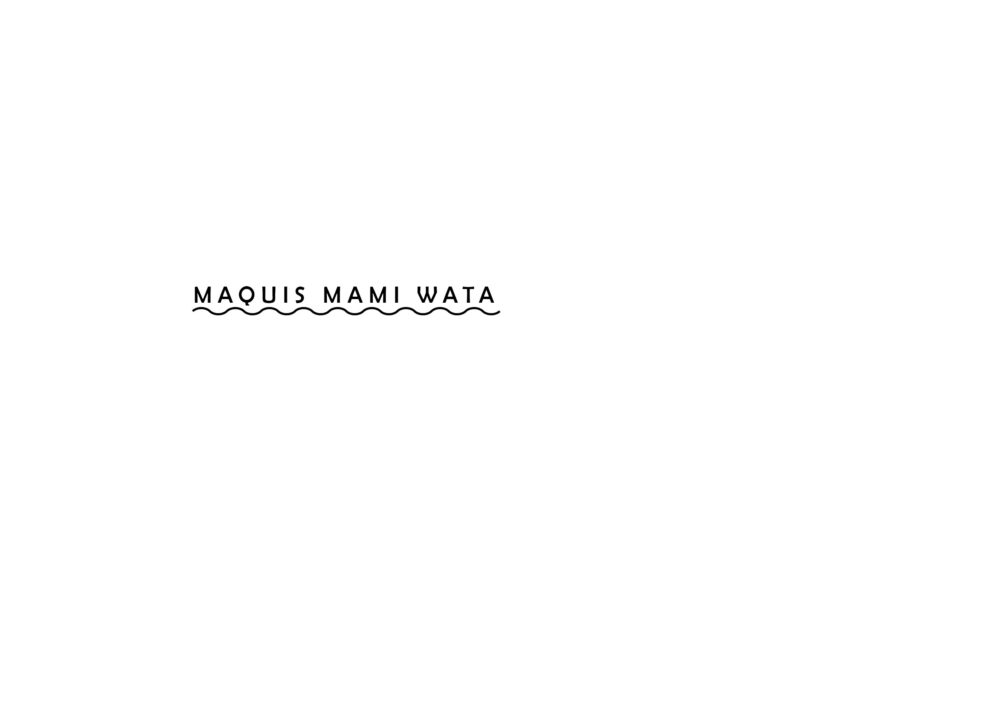
kommende Ausstellung
DARIA WILFING / SHARMILA SAMANT
Daria&Sharmila
05.12.2025 – 10.01.2026
Kuratiert von Stefan Wäldele

aktuelle Ausstellung
WOLFGANG DETERING
Fünf vor zwölf
Kuratiert von Stefan Wäldele
Eröffnung: Sa. 08.11.2025 19 Uhr mit Thomas Schoenberger, Lecture Performance
Schlussveranstaltung: Sa. 29.11.2025 19 Uhr
Künstlergespräch: So. 16.11.2025 16Uhr mit Thomas Schoenberger, Moderation
Öffnungszeiten: sonntags von 16 bis 17 Uhr und nach Vereinbarung

„Yeeeah boyeee! Time to wake up!“
– Flavor Flav (Public Enemy)
©Wolfgang Detering

vergangene Ausstellung
Business Lunch [vom busy sein und busy tun]
Eröffnung: 03.10.2025 19 Uhr mit Salon Bitter und Thomas Schoenberger
Schlussveranstaltung: Fr. 31.10.2025 19 Uhr
Öffnungszeiten: sonntags von 16 bis 17 Uhr und nach Vereinbarung; Lichtmeile 2025

Business Lunch beginnt beim gemeinsamen Essen, Trinken, Kochen oder Zechen. Die dabei entstehenden Kassenzettel nimmt Kai Fischer und überträgt sie großformatig auf Papier – als lakonische Stillleben des Alltags. Eingeladene Künstlerinnen und Künstler reagieren darauf und verwandeln das Gelage in eigene Arbeiten: als Malerei, Kochperformance, Musik oder Skulptur. Mit dabei sind Adam Cmiel (Nürnberg), Arthur Metz (Frankreich), Felix Stöckle (Schweiz), Márton Dés (Berlin/Budapest), Ilwi Kraus (Mannheim), Maximilian Martinez (Mannheim), Stefan Wäldele (Mannheim), Benedikt Hummel (Stuttgart) und die Band Salon Bitter (Stuttgart). Der Ausstellungstraum Maquis Mami Wata wird so zum Treffpunkt, an dem Alltag, Kunst und Austausch ineinanderfließen. Bezugspunkt ist James Ensors „Der tote Hahn“ (1894) aus der Kunsthalle Mannheim, das in Business Lunch in die Gegenwart übersetzt wird – gegessen, geteilt, besprochen und weitergedacht.
– Kai Fischer 2025
13.09. – 28.09.2025
Eröffnung: Sa. 13.09.2025, 20 Uhr mit Thomas Schoenberger (Laudatio)
Schlussveranstaltung: So. 28.09.2025, 18 – 20 Uhr
Öffnungszeiten: sonntags 16 – 17 Uhr und nach Vereinbarung
Kuratiert von Stefan Wäldele

„es geht um das Verhältnis von Original und Kopie, es geht darum was die Aura des Kunstwerks ausmacht, und dass die Aura eben nicht am Kunstwerk klebt, vielmehr dass die Aura auch auf die Vervielfältigungen übergeht, das heisst, dass Original und Kopie eine Symbiose eingehen.
Dass die Rezeption, also das was das Kunstwerk ist, eben viel öfter durch die Kopie als das Original stattfindet. Und am besten kann man das an den Sonnenblumenbilder, die ja eigentlich gar nicht für den Handel bestimmt war, sondern für das maison d´artiste von van Gogh bestimmt waren, weshalb die Besprechung von diesen Sonnenblumen auch immer zögerlich war und man sich lieber an dem verbundenen Ohr des Ohr auf dem Selbstporträt des Künstlers festhält. Also summa sumarum: Original – Kopie – Aura – Decoration“
– Thomas Schönberger 2025
WILFRIED DE PAUL a.k.a WENDLAMITA KOUKA
STRAßENAUSSTELLUNG
Mi. 30.07.2025 16 – 20 Uhr
Kuratiert von Stefan Wäldele


So. 13.07.2025 20:00
„Concerning Violence“ – Neun Szenen der anti-imperialistischen Selbstverteidigung (OmdtU; 85 min)
von: Göran Hugo Olsson
„Concerning Violence“ handelt von den Aufständen, die zur Entkolonialisierung Afrikas führen sollten und ist damit ein Rückblick auf afrikanische Befreiungsbewegungen. Dabei konzentriert sich der Filmemacher auf Archivmaterial, das schwedische Dokumentarfilmer und Fernsehjournalisten zwischen 1966 und 1984 in Afrika aufgenommen haben. Aufnahmen von der Befreiungsbewegung in Angola, der Frelimo in Mozambique und dem Unabhängigkeitskampf in Guinea-Bissau werden dokumentarische Bilder von schwedischen Missionaren in Tansania und einem Streik in einer schwedischen Mine in Liberia gegenübergestellt. Diese Bilder korrespondieren eng mit Texten vom Dekolonialismus-Vordenker Frantz Fanon aus dessen Buch „Die Verdammten dieser Erde“ das die Grundlage für den Dokumentarfilm darstellt. Gesprochen werden die Texte von der Musikerin Lauryn Hill. Im Prolog zum Film stellt die renommierte Wissenschaftlerin Gayatri Chakravorty Spivak Fanons Werk vor und erweitert es um eine Genderperspektive.
© 2014 Filmsboutique.com
PLAY AS POWER
05.07. – 27.07.2025
(Extended Version)
27.07. – 31.08.2025
Kuratiert von Stefan Wäldele

„Jeremiah Quarshie makes people younger. So if you want to look younger, come to me!“
– Jeremiah Quarshie, artist, 2025
©JQ2025
Eröffnung: Sa. 05.07.2025 20 – 22 Uhr
Schlussveranstaltung: So. 27.07.2025 11 – 12 Uhr verlängert bis 31.08.2025
Öffnungszeiten: Sonntags von 20 – 21 Uhr und nach Vereinbarung
Weitere Informationen über https://www.instagram.com/maquismamiwata.de/
SOFT BODIES HARD FEELINGS
06.06. – 29.06.2025


In Helena Renners Arbeiten ist immer auch das interessant / was nicht zu
sehen ist / was abwesend ist und zugleich anwesend / die Zurückweisung
eines imaginären Ideals / die perfekte Linie der Schulter / der Taille / der
Hüften / die perfekte Glattheit der Haut /
Über Körper zu arbeiten heisst immer auch / das Ideal der Norm der Form
mitdenken zu müssen /
…
– Thomas Schoenberger, 2025


– RADIKAL –
25.04. – 25.05.2025
Eröffnung:
AAG 25.4. 19 Uhr, MMW 21 Uhr
Einführung, Ingo Taubhorn
Öffnungszeiten:
AAG So. 16 – 18 Uhr Mi. 18 – 20 Uhr
MMW So. 16 – 17 Uhr Mi. 18 – 19 Uhr
DFA-Mitglieder zu Gast bei Maquis Mami Wata (www.maquismamiwata.de) und dem Atelierhaus Altes Güteramt in Mannheim (www.altes-gueteramt.de):

©Sarah Kirsch 2023/ 2024
SUBURBAN SUNSET
21.03. – 22.04.2025
Eröffnung: Freitag, 21.03.2025, 17–21 Uhr
Schlussveranstaltung: Dienstag, 22.04.2025, 11–13 Uhr
Öffnungszeiten: Sonntags, 16–17 Uhr und nach Vereinbarung
Suburban Sunset. Es sind eigentümliche Helden, die Sarah Kirschs karge Bildräume bewohnen: Wolken, Steine und Büsche, Stoffe und Federn, Eier, Tiere und Möbel, Steppenläufer und Fabelwesen stehen, liegen oder schweben seltsam deplatziert herum, staksen durch die Kulissen der Vorstadt und versuchen vergeblich, sich im nächstbesten Versteck zu verbergen. Je länger unser Blick aber auf ihnen ruht, desto stärker werden diese scheinbar unauffälligen Zeitgenossen, entwickeln ihr skurriles Eigenleben, werden zu eigensinnigen Protagonisten von Sarah Kirschs Geschichten. Und so gibt die Künstlerin dem Nebensächlichen, dem Unbemerkten und Abseitigen, manchmal auch Tollpatschigen eine Bühne. Mit einem präzisen Blick für das Komische im Alltäglichen, für das Skurrile im Monströsen malt sich Sarah Kirsch Schicht für Schicht spielerisch durch die Erinnerung.
– Antonia Marten Kulturwissenschaftlerin, Kunstbüro BW, Karlsruhe/Stuttgart, 2025
„Ich stelle es mir sehr schwer vor, mit einer Wolke einen Korb zu werfen. Es ist wie in einem Traum, in dem man verfolgt wird und nicht von der Stelle kommt. Unerträglich bedrückend. Am besten, man wacht schnell auf.“
– Stefan Wäldele, Kommentar zu SUBURBAN SUNSET von Sarah Kirsch, 2025
Kuratiert von Stefan Wäldele
miniFESPACO – Das kleine panafrikanische Filmfestival in Mannheim
05.-09.03.2025
Kuratiert von Filmemacherin Laurentine BAYALA (BF) und Stefan WÄLDELE

Alle zwei Jahre findet in Burkina Faso das FESPACO statt, eines der größten Filmfestivals auf dem afrikanischen Kontinent. Es ist ein Ort, um neue Regisseure und Regisseurinnen zu entdecken und sich ein Bild von den Filmtrends in den verschiedenen Regionen zu machen.
Die fünf Filme, die Stefan WÄLDELE und ich für das zweite miniFESPACO im Maquis Mami Wata in Mannheim ausgewählt haben, werfen einen anderen Blick auf den afrikanischen Kontinent, der meist nur aus einem Blickwinkel betrachtet wird. Afrika besteht nicht nur aus Konflikten und Elend. Männer und Frauen träumen und kämpfen dort, um sich voll zu entfalten.
Durch unsere Zusammenarbeit wollen laurentine BAYALA und ich das FESPACO bekannt machen und afrikanische Filme in Mannheim zeigen. Vorführungsort ist neben dem Maquis Mami Wata dieses Jahr das Kommunale Kino Cinema Quadrat e.V.
miniFESPACO ist ein Kunstwerk. Die Filmauswahl bietet einen Einblick in ein vom Westen geprägtes Afrika. Konflikte zwischen Traditionen und westlichen Konzepten werden humorvoll umgesetzt. Unabhängigkeit und Freiheit werden in Nî Chaînes Nî Maîtres (2024) von Simon MOUTAIROU deutlich.
text: Laurentine BAYALA und Stefan WÄLDELE, 2025
Programm:
Bal Poussière (1988) | Henri DUPARC (CIV) | OmeU | 91min | FSK – | 05.03.2025 | 20:00 | Maquis Mami Wata
La Vie Est Belle (1988) | Ngangura MWEZE, Benoît LAMY (COD/BEL) | Original | 80min | FSK – | 06.03.2025 | 20:00 | Maquis Mami Wata
You Will Die At Twenty (2019) | Amjad Abu Alala (SDN) | OmdU | 103min | FSK 12 | 07.03.2025 | 20:00 | Cinema Quadrat e.V.
Augure (2023) | BALOJI (COD/BEL) | OmdU | 92min | FSK 12 | 08.03.2025 | 20:00 | Maquis Mami Wata
Nî Chaînes Nî Maîtres (2024) | Simon MOUTAIROU (BEN/FRA) | OmfU | 93min | FSK 16 | 09.03.2025 | 20:00 | Maquis Mami Wata
©Stefan Wäldele, Plakat_miniFESPACO, 2025
ANNA SIEBERT, ENVER ISUFI, POLLO GUZMAN, MORITZ STOTZKA, ANNETTE ZOBEL
ATELIER SCHULSTRAßE 01.02. – 01.03.2025 im Maquis Mami Wata
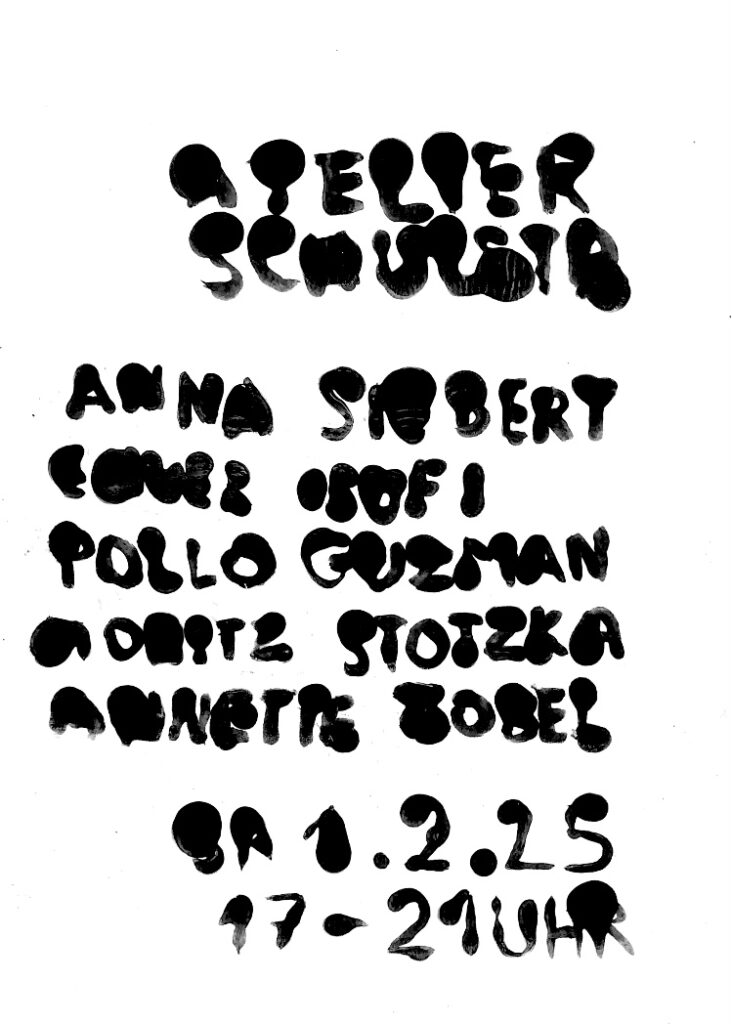
Eröffnung: Sa. 01.02.2025, 17 – 21 Uhr | Künstlergespräch: Sa. 15.02.2025, 18 Uhr | Öffnungszeiten: jeden Sonntag von 16 bis 17 Uhr und nach Vereinbarung | Schlussveranstaltung: Sa. 01.03.2025 | 17 – 19 Uhr
Konzept: Stefan Wäldele, 2024
©Stefan Wäldele, Plakat_Atelier_Schulstr., 2025
Needle In The Hay 18.09.24 – 13.11.24
„Needle In The Hay“ by artist Aljoscha Heims is an exhibition curated by Stefan Wäldele: When Maquis Mami Wata meets Shopping Cité Baden-Baden.
©Stefan Wäldele, Poster NITH_A.H., 2024

Thomas Schoenberger / Lecture Performance / 18.9.24 /
Shopping Cité Baden-Baden / Ausstellung Aljoscha Heims /
Kuratiert von Stefan Wäldele / Maquis Mami Wata /
Zunächst der Text von Aljoscha Heims und Jonas Wolfgang Lundius:
Ich demaskiere, ich träume, ich male Fressen in Bücher, ich male
Fressenbücher, aus Erinnerungen,
aus Träumen, in Isolation, ich bin besessen, als wäre ich ein Sessel, für
Fressen, Gespenster sind
auch mit von der Partie, alles tritt in den Vordergrund, alles Fressen.
Aber alles easy. Während die Welt verschwimmt, sich zersetzt,
transparenter wird, liege ich im Bett und mal weiter meine Fressen.
Soweit der Text von Aljoscha Heims und Jonas Wolfgang Lundius
Über die Fressen von Aljoscha
Warum schreiben Künstler Texte über sich selbst?
Warum schreiben sie überhaupt Texte?
Ganz einfach:
Weil ihnen gar nichts anderes übrigbleibt /
…
– Thomas Schoenberger, 2024
IMAGINE 14.09. – 17.11.24
©Claus Stolz, Kammerspiel #185, 2022

Light, material, data, code and idea – for Claus Stolz, photography is process, transformation, subversion: while in his “Heliographs” the image is identical to the motif, the “Light Images” surprise with the beauty of photographic material and the “Chamber Plays” with their absurd authenticity, in his most recent works the idea becomes the motif.
Text: Claus Stolz
CINÉMA BURKINA! 19.10.2024
„MOUNIRA“ 7:37 min (OVGerSub), 2023
TANJA SCHOLZ &KAI SONNENFELS
GLÜCKSGEFÜHLE 20.07. – 08.09.2024
©Tanja Scholz 2023

KIMAERA STUDIO 12.07. – 13.07.2024
Wir bitten ins kimaera studio: Technoider Beauty-Salon, virtueller Feelbetterspace und die Verschmelzung von Mensch und Maschine – eine Installation basierend auf der gleichnamigen Performance. Im Rahmen des Schwindelfrei Festivals entwickeln die drei Künstler*innen im Mannheimer Maquis Mami Wata eine begehbare Rauminstallation aufbauend auf der Bühnenperformance.
Die multimediale Bildsprache eröffnet einen Denkraum über das Erweitern, Verbessern und Verändern von Körper und Psyche.
Die kybernetische Symbiose mit der Maschine verspricht die Optimierung der Optimierung. Aber was soll optimiert werden? Was ist eigentlich defizitär und wer entscheidet darüber?
KFC suite sind die intermedial arbeitenden Mannheimer Künstler*innen Katharina Anna-Josefine Rausch, Christopher Johannes Scheuer und Friedrich Stockmeier. In ihren Bühnenperformances verbinden KFC suite Musiktheater, Live-Elektronik, Augmented Reality, Sensorik, Video und Installation.
Zuletzt entstand die Musiktheater-Performance „kimaera studio“.
Text: KFC suite
VOODOO RAINBOW 05.05. – 30.06.2024
Orig.: ©SOUL OF AFRICA Museum 2022 / ©SW2024
Bild: „Plakat6/14“, Sprühlack, Schablone, Plakat, DIN A3, Stefan Wäldele, Mannheim, 2024
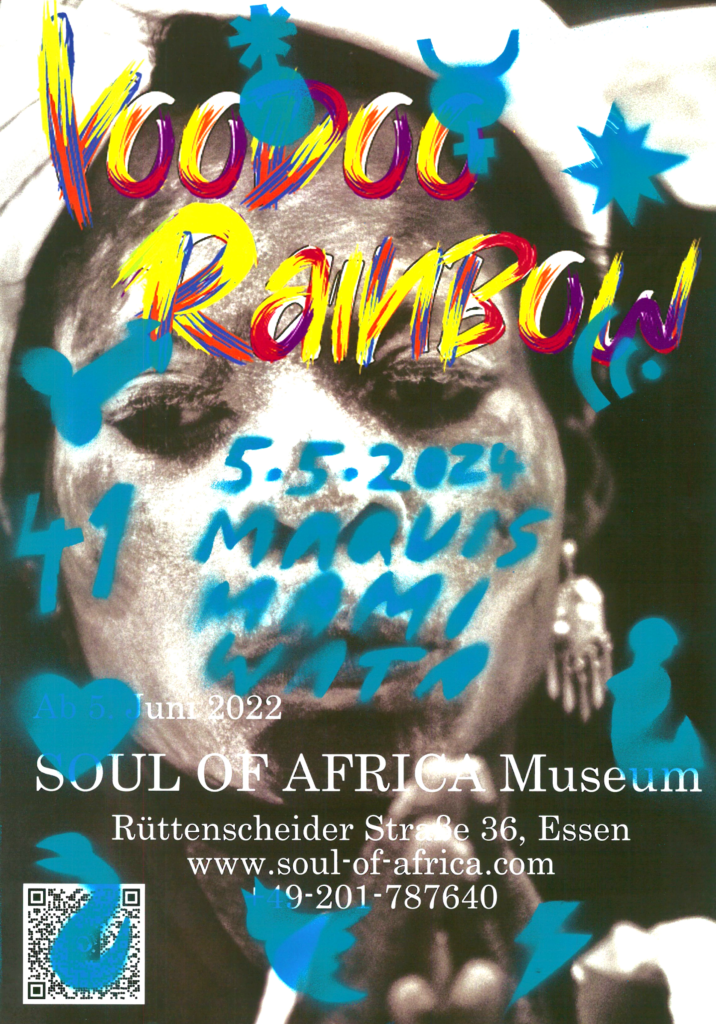
mit Werken aus der Sammlung von SOUL OF AFRICA Museum, Essen.
„VOODOO RAINBOW“
im Maquis Mami Wata.
WIFI, die schnelle Verbindung zu unseren Ahnen. „41“, die magische Zahl. Blau, die Farbe des Wassers. Mami Wata, die Göttin der Außenseiter:innen. Voodoo Rainbow, die Ausstellung in Essen. Voodoo Rainbow im Maquis Mami Wata.
text: Stefan Wäldele, 2024
„VOODOO RAINBOW“
Die Ausstellung im SOUL OF AFRICA Museum.
In der Ausstellung „Voodoo Rainbow“ wird die Verbreitung der Religionen West- und Zentralafrikas durch den transatlantischen Sklavenhandel näher erklärt. Schätzungsweise 12 Millionen Afrikaner wurden in die Kolonien der „neuen Welt“ verschleppt, etwa 20% überlebten die Überfahrt nicht. Religionen, wie der westafrikanische „Vodun“, vermischten sich in den Kolonien mit den Religionen anderer Versklavter, dem Glauben der indigenen Bevölkerungen und dem Christentum der Europäer. Daraus entstanden faszinierende Religionen und Kulturen, die nicht nur die Sklaverei und den Kolonialismus überlebten, sondern sich bis heute weiterentwickelt haben und immer mehr an Popularität gewinnen. „Voodoo Rainbow“ zeigt ab dem 01. Juni 2022 die Ursprünge verschiedener Religionen auf dem afrikanischen Kontinent und daraus resultierende Diaspora-Religionen aus Kuba, Haiti und Brasilien. Wie bereits in vorherigen Ausstellungen können Besucher sich auf verschiedenste Objekte aus Westafrika freuen, unter anderem auch auf den beliebten „Mami Wata“ Altar, der aktiviert ist und somit auch benutzt werden kann! Neben diesen altbekannten Ausstellungsstücken, zeigt das SOUL OF AFRICA Museum aber auch viele neue Objekte aus der afrikanischen Diaspora. Aus Kuba zeigt das Museum die Religionen „Santeria“ und „Palo Mayombe“, aus Haiti „Vodou“ und Objekte aus der Vodou-Geheimgesellschaft „Bizango“. Aus Brasilien können Besucher sich Figuren und Hintergründe zu den Religionen „Umbanda“ und „Quimbanda“ erklären lassen. Besonders spannend dabei ist die Aufteilung der Götter und Geister in „gut“ und „böse“, die sich in all diesen Religionen finden lässt. Außerdem wird auch das Thema “ Sklaverei“ einen größereren Platz als bisher einnehmen. Historische Dokumente und Objekte des transatlantischen Sklavenhandels helfen dabei bei der Veranschaulichung. „Voodoo Rainbow“ besteht also auch aus vielen neuen und bisher noch nicht gezeigten Objekten aus verschiedenen Teilen der Welt. Freuen Sie sich auf eine einzigartige Reise durch die Kulturen Westafrikas über die Karibik nach Südamerika!
text: Henning Christoph, 2022
miniFESPACO mit LAURENTINE BAYALA
miniFESPACO 18. – 21.04.2024
Orig.:©FESPACO 1985 / ©SW 2024
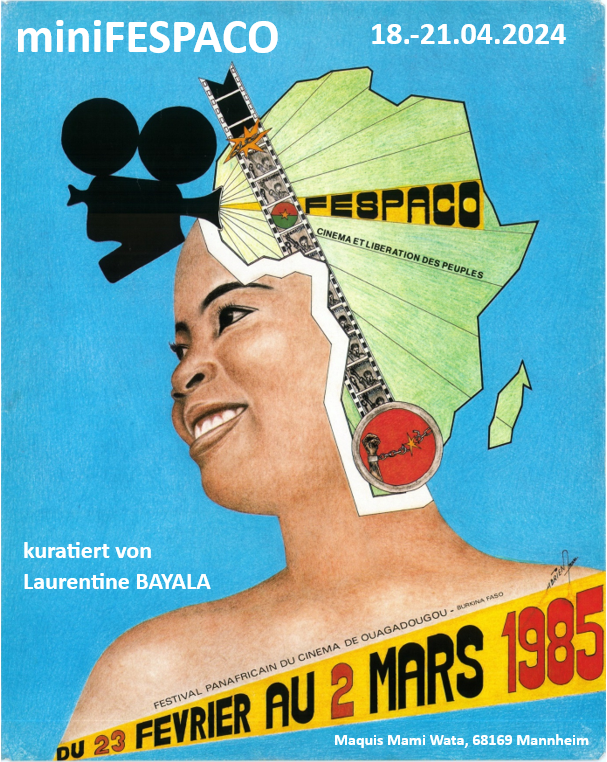
Alle zwei Jahre findet in Burkina Faso das FESPACO statt, eines der größten Filmfestivals auf dem afrikanischen Kontinent. Es ist ein Ort, um neue Regisseure zu entdecken und sich ein Bild von den Filmtrends in den verschiedenen Regionen zu machen.
Die vier Filme, die ich für das miniFESPACO im Maquis Mami Wata in Mannheim ausgewählt habe, waren Teil des FESPACO-Programms. Sie werfen einen anderen Blick auf den afrikanischen Kontinent, der meist nur aus einem Blickwinkel betrachtet wird. Afrika besteht nicht nur aus Konflikten und Elend. Männer und Frauen träumen und kämpfen dort, um sich voll zu entfalten.
Durch die Zusammenarbeit mit Stefan Wäldele wollen wir das FESPACO bekannt machen und westafrikanische Filme in Mannheim zeigen.
miniFESPACO ist ein künstlerisches Konzept.
text: Marie Laurentine BAYALA 2024
« Notre continent, bien que rongé par tant de problèmes internes et externes, est plus vivant que jamais. Nous devons faire preuve d’audace et reconquérir notre espace culturel et cinématographique. »
-Ousmane Sembène, 1995
Quelle: Black Camera, Okt 2021
Espoir Voyage (2010) | Michel ZONGO (BF) | 18.04.2024 | 20:20 | OmU (eng) | 80min
Traverser (2020) | Joel AKAFOU (CI) | 19.04.2024 | 20:20 | OmU (eng) | 77min
Une femme pas comme les autres (2009) | Abdoulaye DAO (BF) | 20.04.2024 | 20:20 | OmU (eng) | 100min
Buud Yam (1997) | Gaston J-M KABORÉ (BF) | 21.04.2024 | 20:20 | OmU (eng) | 100min
Stille Spricht 21.03.2024 – Premiere
Wie gehen wir mit existentieller, körperlicher und sexueller Scham um?
Wie können wir Resilienzfaktoren stärken und einen Weg finden, aus der Scham
herauszutreten?
Stille spricht ist eine Tanzproduktion von Mike Planz, die sich mit dem Gefühl von Scham auseinandersetzt und seine Inspiration aus dem gleichnamigen Buch des französischen Neurologen und Psychiaters Boris Cyrulnik bezieht.
In Zusammenarbeit mit den PerformerInnen Sade Mamedova, Kevin Albancando, dem Musiker Carlos Trujillo und dem Tanztherapeuten Michael Bronczkowski soll das Thema Scham auf mehreren Ebenen verhandelt werden. In der Galerie Maquis Mami Wata, laden wir sie auf kleinstem Raum auf eine intensive Begegnung zwischen PerformerInnen und Publikum ein. Wir möchten der Scham einen Raum geben, ihr zuhören, sie aushalten und Wege finden sie zu überwinden.
„Ungeteilte Emotionen schaffen in der Seele des Opfers einen Raum des Schweigens, der ohne Unterlass spricht. In diesem Raum des Schweigens empfindet man Gefühle wie Scham und Angst, kann diese jedoch nicht mit der Außenwelt teilen, da man befürchtet, verurteilt oder abgelehnt zu werden.“ (Boris Cyrulnik, Scham)
screening 08.03.2024 at 8pm
Mannheimer Filmpremiere!

DR. GABRIELE PIEKE (CURATOR)
Egypt Recoloured 27.01. – 03.03.2024
„Egypt Recoloured“ is an exhibition concept by artist Stefan Wäldele.
©bild: Stefan Wäldele Green Djoser 2024
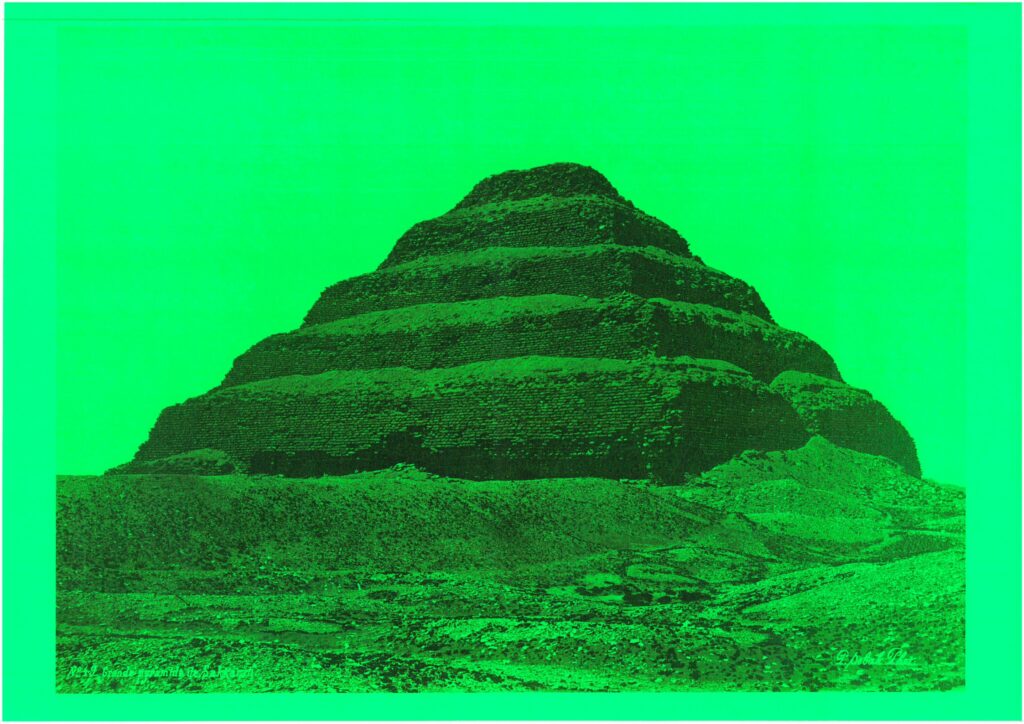
Egypt Recoloured
in collaboration with the Reiss-Engelhorn-Museen Mannheim
© photo: Pascal Sébah, Step Pyramid of King Djoser (ca. 2650-2620 BC) in Saqqara, 1875 – Reiss-Engelhorn-Museen Mannheim, Wilhelm Reiß Collection, Ae07/03
cover: Stefan Wäldele, Green Djoser, 2024
©flyer: Stefan Wäldele Liebesbrief an Mo Edoga 2023
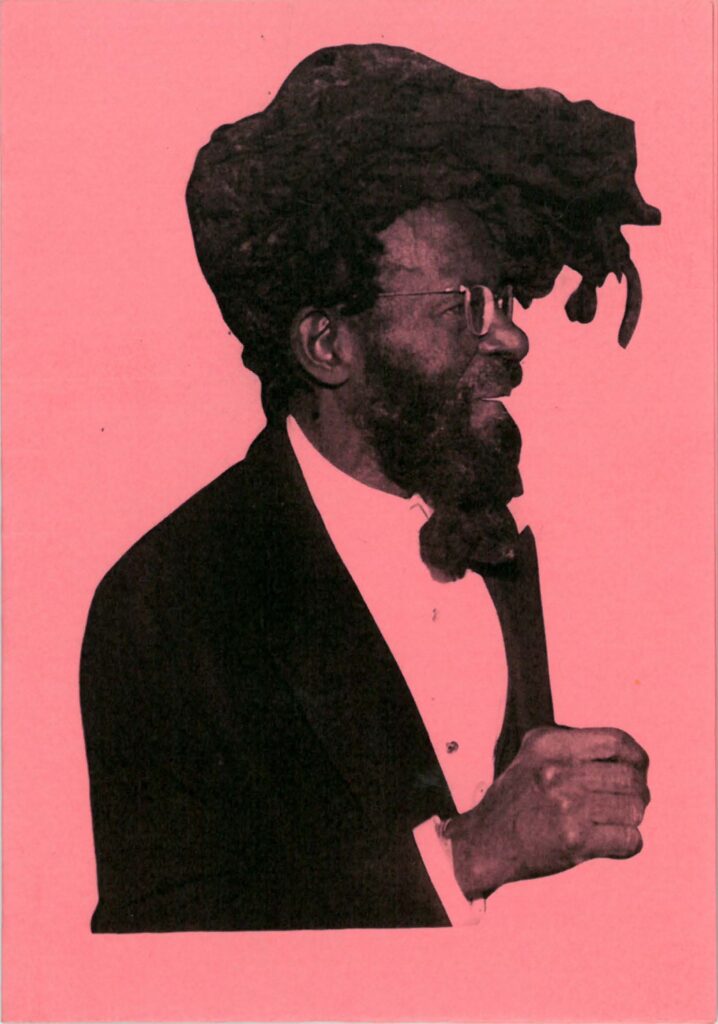
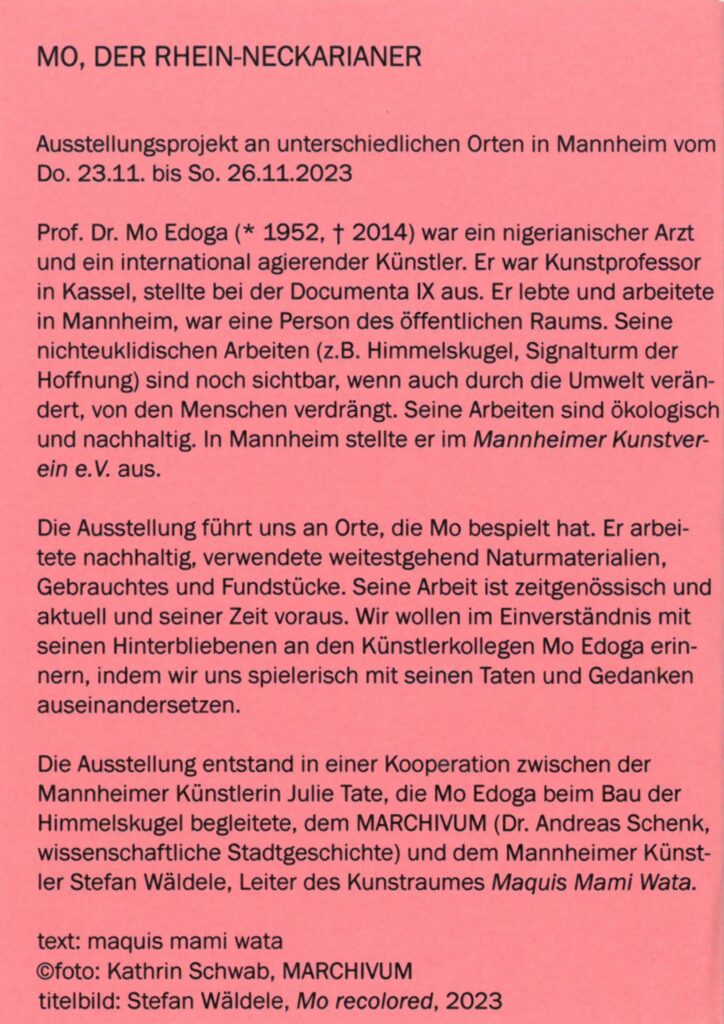
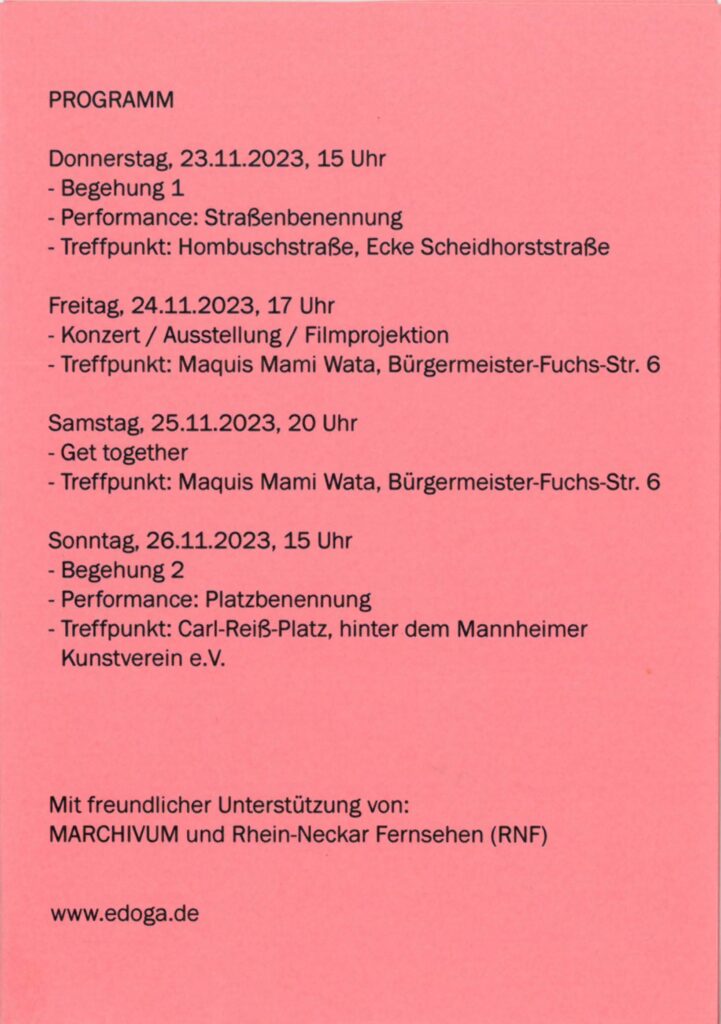

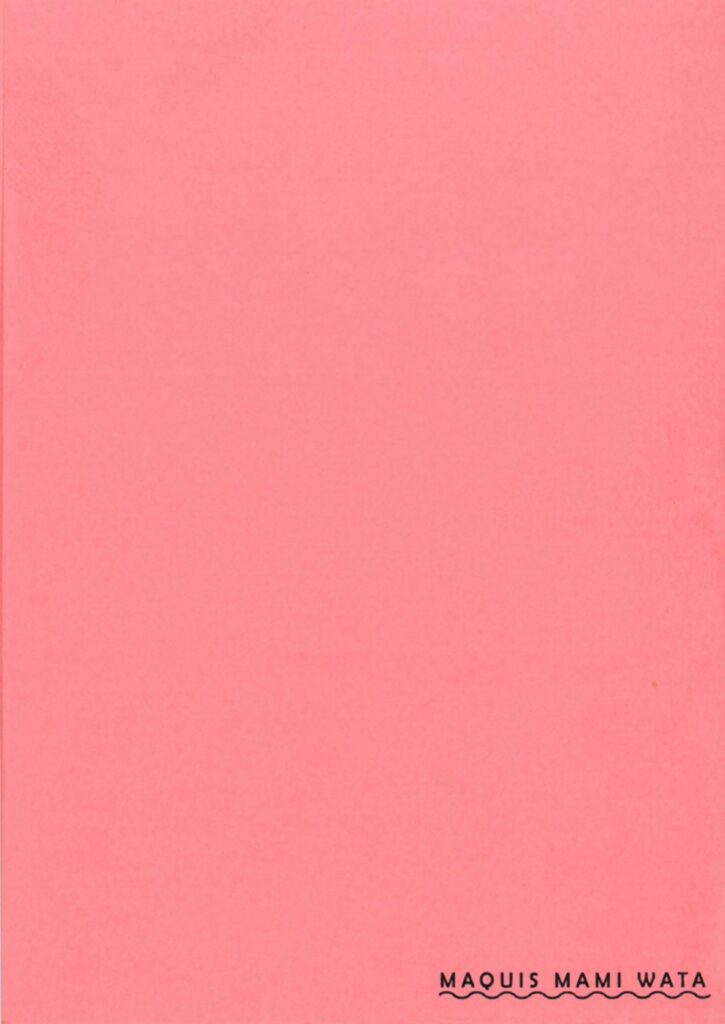
STEFAN WÄLDELE
NJOI 18.11. – 19.11.2023
©Stefan Wäldele flyer 2023

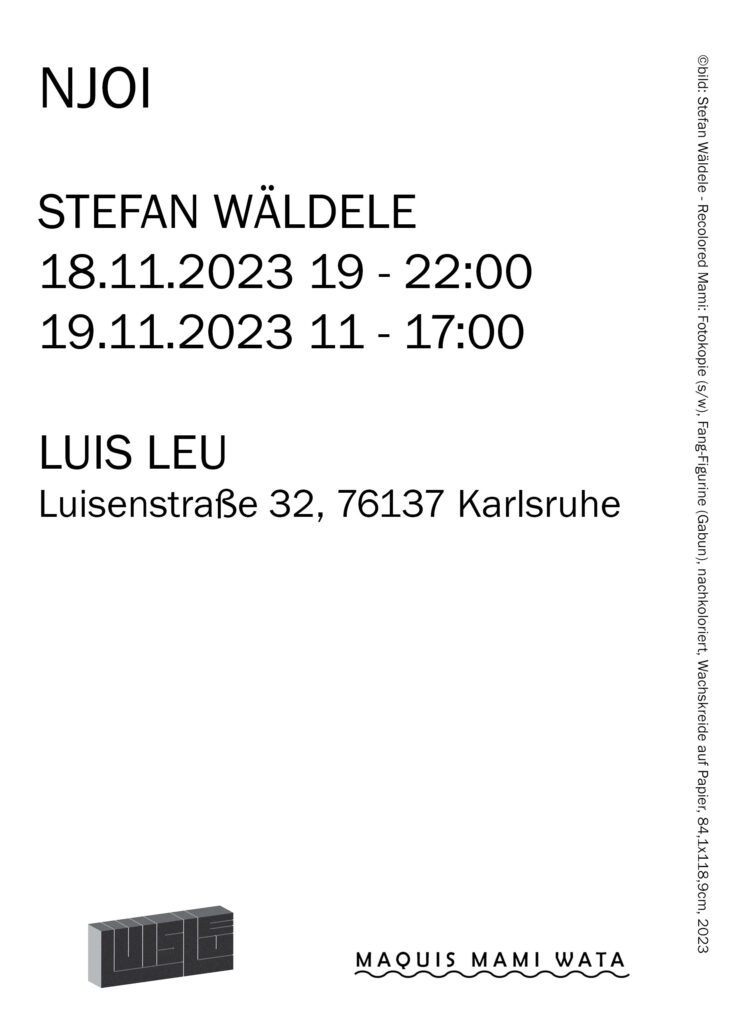
STRONG 06.10. – 05.11.2023

HIROKO NAGATA & RYOSUKE YAMAUCHI
GHOST OF EXHIBITION 展示の幽霊 16.09. – 01.10.2023
©Hiroko Nagata & Ryosuke Yamauchi flyer 2023

“Ghost of Exhibition” ist eine Ausstellung für Geister.
Diese Ausstellung kehrt die Beziehung zwischen Menschen und Geistern durch die Werke und Raum um. Der Betrachter wird in die Lage eines Geistes versetzt, der irrtümlich in den menschlichen Bereich eingedrungen ist. Eine Ausstellung, die für Geister geeignet ist, kann für Menschen etwas unangenehm sein. Man kann jedoch sagen, dass sie die Welt aus der Sicht des Geistes erleben.
”Ghost of Exhibition”は幽霊のための展示です。
この展覧会は作品と空間を通して人間と幽霊の関係を逆転させる。鑑賞者は間違って人間の領域に侵入してしまった幽霊の立場に置かれる。幽霊にふさわしい展示は、人間にとってはいささか居心地が悪いかもしれない。しかし、それは幽霊の視点から世界を体験しているともいえる。
„Ghost of Exhibition“ is an exhibition for ghosts.
This exhibition reverses the relationship between humans and ghosts through the works and space. The viewer is put in the position of a ghost who has mistakenly entered the human realm. An exhibition suitable for spirits may be somewhat uncomfortable for humans. However, it can be said that they experience the world from the spirit’s point of view.
text: Ryosuke Yamauchi
GOD HANDED ME THE GIFT 09.09.2023
©MCGARTEN 2023
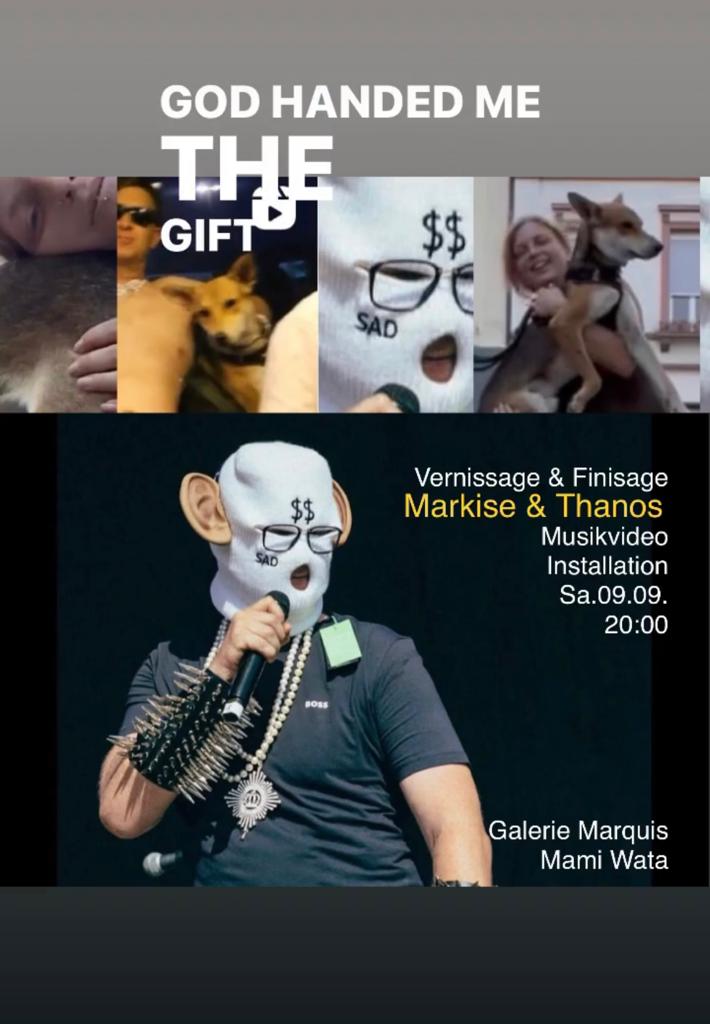
NGOZI SCHOMMERS & SEBASTIAN DANNENBERG
WORK HARD, JUST WORK HARD. 16.07. – 22.08.2023
©Ngozi Schommers & Sebastian Dannenberg 2023
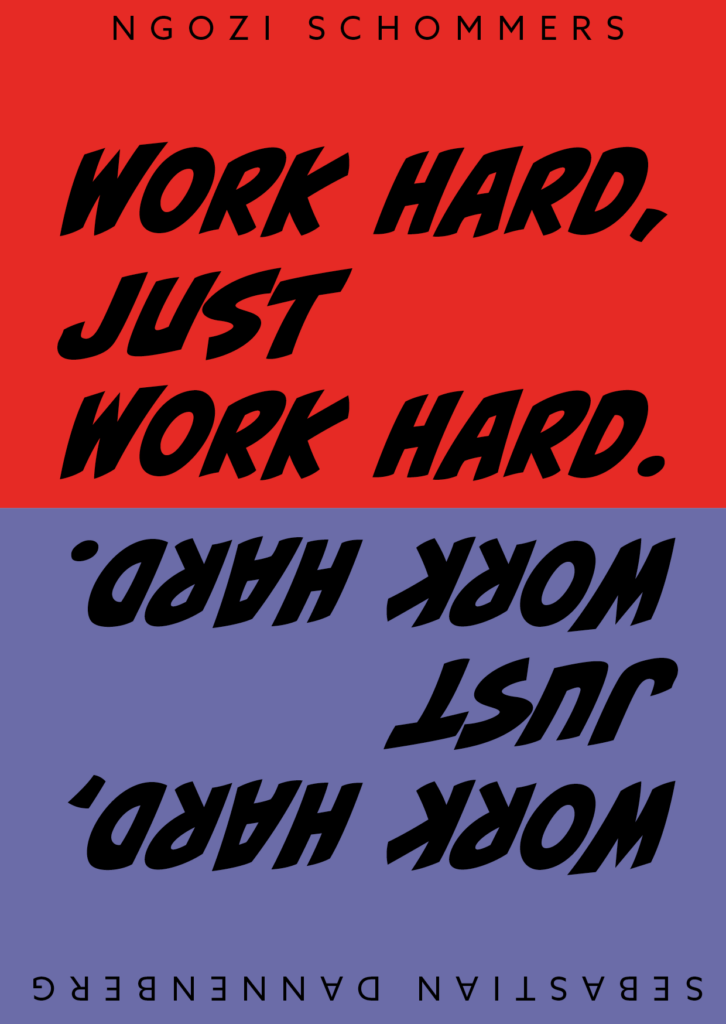
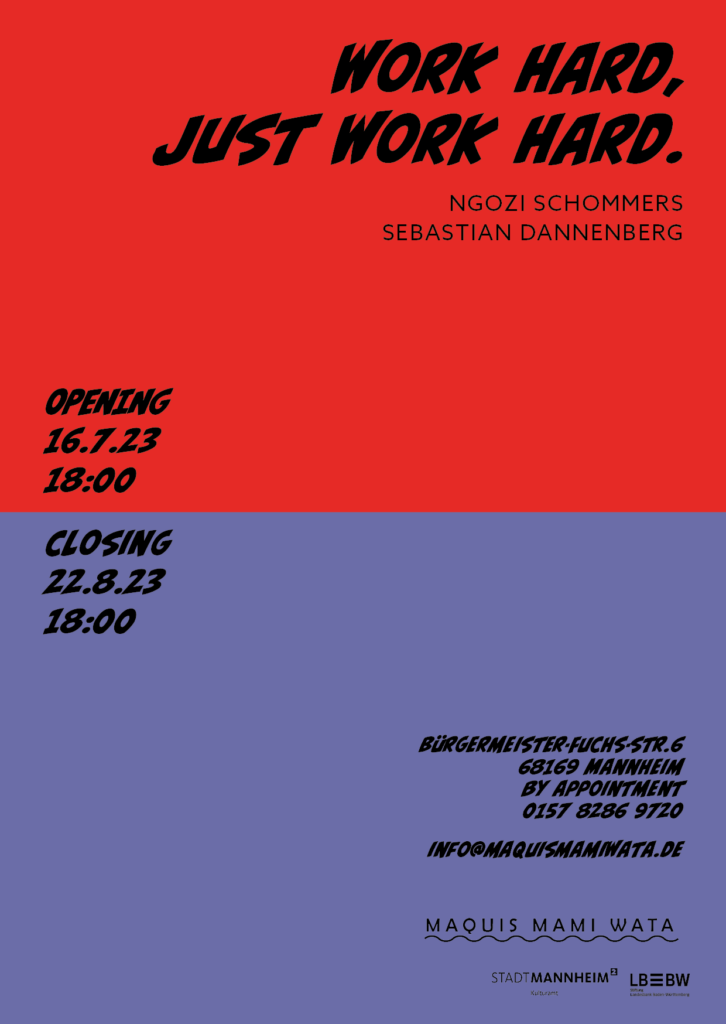
WORK HARD, JUST WORK HARD.
Was heißt es zu arbeiten?
Wann fängt Arbeit an?
Ist es Arbeit, neugierig zu sein?
Ist es Arbeit, seinen Mitmenschen mit
Respekt zu begegnen?
Ist es Arbeit, sich strukturellem Rassismus
zu stellen und sich in eine verandernde
Gesellschaft einzutragen?
16:47
Ein Pinselstrich, schwarz auf weiß, vertikal, ertastet
die Physis des Raumes, scheint ihn zu vermessen.
Beginnend auf der Ausstellungswand, endet er trocken
und und scheinbar unbeendet auf einem Volumen,
das in den Raum ragt. Das matte Weiss stellt die
Verbindung zwischen der ortsbezogenen skulpturalen
Setzung und der Ausstellungswand her. Man meint,
fast einen Zeitraum sehen zu können, die Dauer des
Kontaktes von Pinsel mit Farbe und Untergrund. Die
physische Präsenz von Farbe fordert unsere eigene
körperliche Anwesenheit. Erst die Menschen im Raum,
still oder in Bewegung, aktivieren das Kunstwerk.
18:00
Schwerer weißer Stoff, scheinbar wahllos in Falten,
hängt über einer Aluminiumstange im Raum. Parallel
zur rechten Wand auf einer Höhe von vielleicht 180cm,
schwebt das Raw Material, wie abgelegt, viel mehr
abgehängt, eine Benutzung oder Weiterverarbeitung
scheinen nicht ausgeschlossen, sondern eher nötig.
Auf dem Stoff ist in schwarzen breiten Lettern
ein kurzer Text zu lesen, der an einen Comicdialog
erinnert. WORK HARD! JUST WORK HARD
…KEEP WORKING HARD. NO, JUST WORK HARD!
…CONTINUE TO WORK HARD! Diese Aufforderung
oder Ermahnung wiederholt sich, samt seiner um 180
Grad gedrehten Entsprechung, gleich einem Muster,
auf der ganzen
Stoffbahn in regelmäßigen Abständen. Das Werk
fordert nach einer Haltung der Betrachter*innen.
Der zu lesende Imperativ des Textes, die lapidare
Erscheinung des Materials suchen nach Erklärung und
Entsprechung.
19:12
Papier über Papier unter Papier. Eine Serie von
invertierten Schriftzügen auf Papier, teilweise
verwischt und ausgewaschen, teilweise scharf und
kontrastreich, in allen der Pinselstrich, die Geste
anwesend. Ein unsymmetrisches Raster aus 10
Blättern, ebenfalls WORK HARD. proklamierend.
Die Betrachtenden werden zu Protagonist*innen,
sie scheinen es auszusprechen, wie bereits in 18:00
werden auch in 19:12 die Typografie und Aussage
gedoppelt und wiederholt, sich nur in Erscheinung und
Ausführung ändernd. In Leserichtung auslaufend und
zusehends verschwommener werdend, wird der Block
durch zwei Papierarbeiten ergänzt, die wie ein Subjekt
neben der Aufforderung erscheinen. In der einen
Zeichnung erscheint ein Strudel aus feinen braunen
Tuschelinien, die an Haare erinnern, in der anderen, die
eine Stütze zeigt, mäandern gezeichnete Zöpfe.
text: Sebastian Dannenberg
Funmi Oyewale/ FLAUNTA
GANG GANG BITCH 24.06 – 14.07.2023
Eine Ausstellung über die transformative Potenz der Wut.
WUT IST DIE GROßE SCHWESTER VON ANGST. Angst bedeutet Schwäche. Schwäche hat keinen Platz in einer Gesellschaft, die sich diese zwar leisten kann aber verlernt hat, wahre Verletzlichkeit einzugestehen, auszusprechen, auszuhalten, anzunehmen. Wut ist unschön, unweiblich, unkontrolliert und unpassend. Wut ist gefürchtet und verpönt, sowohl in ihrer aggressiven als auch in ihrer passiven Form. Wut entzweit, sie fällt auf- unangenehm, störend, soll unterdrückt, intellektualisiert, weggeatmet, kontrolliert geschluckt werden.
WUT IST DIE GROßE SCHWESTER VON ANGST und haut jedem eine rein, der der kleinen Schwester zu nah kommt!
Sie ist ein Eingeständnis von Ohnmacht, Hilflosigkeit und zugleich ein essentieller Befreiungsschlag; der erste, aktive Protest, gegen die Bedrohung, gegen die Machtlosigkeit; der unbeholfene Versuch, sich aus der Opferrolle zu lösen. Wut bedeutet Grenzen ziehen; ungelenk und impulsiv. Sie ist unüberlegt und fehlerhaft und gerade deshalb angreifbar, Scham behaftet und stigmatisiert. In der Ausstellung GANG GANG BITCH behandelt die Künstlerin das Thema Wut als liebevollen Akt der Selbstliebe. Die hier gezeigten Arbeiten setzen sich mit dem transformativen Potential weiblicher Wut auseinander. Die Künstlerin will dem Gefühl Raum schaffen, es enttabuisieren.
,, Um Wut loslassen zu können, muss man sie zu allererst einmal annehmen. Aggression zuzulassen ist ein wichtiger Schritt hin zur Selbstakzeptanz und Selbstakzeptanz ist der eigentlich wahre Grundbaustein der Freiheit.
So, here I am, in all my glory, warts and all. Gang Gang Bitch. „
ISAAC GODFREY GEOFFREY NABWANA
WAKALIWOOD
13.10. – 14.10.2023


Thomas Schnurr
„… oder die Schönheit des letzten Gedankens“ 02.06. – 18.06.2023
Tebda Talato

Tõnd Yēgre 26.04. – 17.05.2023
Talato lives and works in Ouagadougou. She is the founder of Les Petits Beaux Arts du Burkina an artists association in Ouagadougou. It is Talato’s attempt to establish a free art school in her country. Tous pour l‘ art, l‘ art pour tous.
text: Stefan Wäldele; bild: T.Agnès und ©sw2025
FÜR DIE STERNE 23.02. – 26.03.2023
CACOPHONIC EXERCISE No.2 18.02.2023 at 8pm
Summer School „Afrika in Bewegung“
02.08.2022
©Sabine Jell- Bahlsen filmstill

Movie: Mammy Water – In search of the water spirits in Nigeria by Sabine Jell- Bahlsen
color, 60 min, 1989
On the second evening of the summer school, we visited the gallery Maquis
Mami Wata to dive into one of Nigeria’s spiritual belief systems.
The evening started with a short introduction by the gallerist and artist Stefan
Wäldele, who introduced the participants to the spiritual tradition of Mammy
Wata. Andrea Chagas then contextualized the importance of acknowledging
the spiritual practices embedded in many African cultures. This
embeddedness is needed in order to reframe the „integration politic“ and
change it to an „inclusion politic“.
In order to allow people to include themselves in European social settings, people living in the
migrational ‚receiving countries‘ (e.g., in Europe) need to get accustomed to spiritual and
cultural practices that differ highly from, e.g. Catholicism, Islam or Judaism. The spiritual belief system of the Yoruba people (Ibibio, Ijaw and Igbo) is present on both sides of the Atlantic (Africa and the Americas). It plays a crucial role in the development of syncretic belief systems in the Americas (e.g., Santería (Cuba), Candomblé (Brazil, Uruguay, etc.), and Shangó
(Trinidad). In Europe, a few Africans and Afro-European people practice worshipping their
traditional deities in the diaspora. However, the extent of the practice is unknown since these
practices are often kept secret.
The documentary „Mammy Water – In search of the water spirit in Nigeria“ introduced
the deity and ritual practices embedded in cultural traditions and social practices.
Mammy water is one of the Pidgin English names used to refer to the water goddess,
worshiped by the Ibibio, Ijaw, and Igbo peoples that live in southeastern Nigeria. This
goddess has many names according to the tradition she belongs to. Mammy water is
recognized as the mother that provides wealth, success and health to her children
according to the tradition depicted in the documentary.
This documentary shows numerous rituals and ceremonies associated with worshiping the
water goddess in the 80s of the last century. It can be seen that the worshipping and
ceremonies depicted in the film are deeply embedded and rooted in sociocultural practices.
Worshipping Mammy Water provides a social coherence built around spiritual and ritual
practices. Jacob Olupona, professor of indigenous African religions at Harvard Divinity School
and professor of African and African-American studies in Harvard’s Faculty of Arts and
Sciences, for example, comments that „African spirituality simply acknowledges that beliefs
and practices touch on and inform every facet of human life, and therefore African religion
cannot be separated from the everyday or mundane“ (Harvard Gazette, 2015). What Olupona
points out can be clearly seen in the film since it shows how spirituality and rituals are
incorporated into mundane everyday activities and also special festivities.
After the film, students asked about the significance of the color orange since it was very
present in the film. Wäldele said that the color orange is associated with the deity. Andrea then added that orange represents the sacral chakra in the chakra system. This chakra represents creativity, creation, and desires and is water-related. Many symbolisms are recurrent in different spiritual practices and traditions (yoga, chakra system – Mammy Wata, water symbolism). Both belief systems do not have anything in common but share the same
characteristics attributed to an element and a color. Exploring different cultures and spiritual
practices can show us that in seemingly very distinct traditions, we can also find similarities
that bring us together.
Literature:
Harvard Gazette (2015). The spirituality of Africa, accessible online at
https://news.harvard.edu/gazette/story/2015/10/the-spirituality-of-africa/
text: Andrea Chagas
Skin Politics 08.07.2022
3 Short Films >>> ongoing project
La Promesse 23.11.2022
La Lutte Continue 27.11.2022
Mounira 19.10.2024
Mind and World 12.12.2020 – 31.01.2021
Er ist ich und ich bin Du 02.07. – 25.07.2022
Aljoscha Heims
*Hi, how are you ? 06.06.– 26.06.2020
Geister im Kopf 05.11. – 11.12.2021
Reaching towards 10.03. – 13.03.2022
Henny Herz
In a constant flow 13.06.2022
Rebekka Brunke and Barbara Hindahl
Chimäre und Zeichentricks 02.07. – 31.07.2021
An exhibition curated by Rebekka Brunke and Barbara Hindahl.
Exhibiting artists: Harald Kröner, Annick Blavier, Heimo Wallner, Hedya Klein, Matthias Beckmann, Hanna Hennenkemper, Rebekka Brunke, Barbara Hindahl
Olga Jakob and Hannah Gottschalk
Rote Neon 18.09. – 23.10.2021
Cleopatra – How far can I go? 14.05. – 11.06.2022
Sarah Kirsch
Such Dir einen Ort und schlafe 22.04. – 07.05.2022
Margarita Kopp
Dream on 07.08. – 30.08.2020
Charmantes Flüstern 10.07. – 02.08.2020
Das gute Bild 21.11. – 29.11.2020
Malerei / Painting 09.09. – 04.10.2022
Carmen Rita Maria Ott
Yinmotion into Firefox 06.08.2022
When no one is watching 20.12. – 22.12.2022
A short movie version of the piece When no one is watching inspired by the novel of the same name by Alyssa Cole.
Visited by a tiger 03.09. – 06.09.2020
A video piece in two chapters.
A conversation between the fist as a model of the brain and as the iconic symbole for struggle, resistance and solidarity.
International residency 01.12. – 18.12.2021
Studio Pam Pam – Mannheim ist Warren Sare 06.01.2022
Sebastian Schommers
It´s a jungle out there – Stay Gold 10.12. – 18.12.2022
Momo Weinert
Tröpfchen 07.10. – 05.11.2022
Freddy Witz
Please show you´re not a robot 25.09. – 24.10.2020
©Freddy Witz, 2020
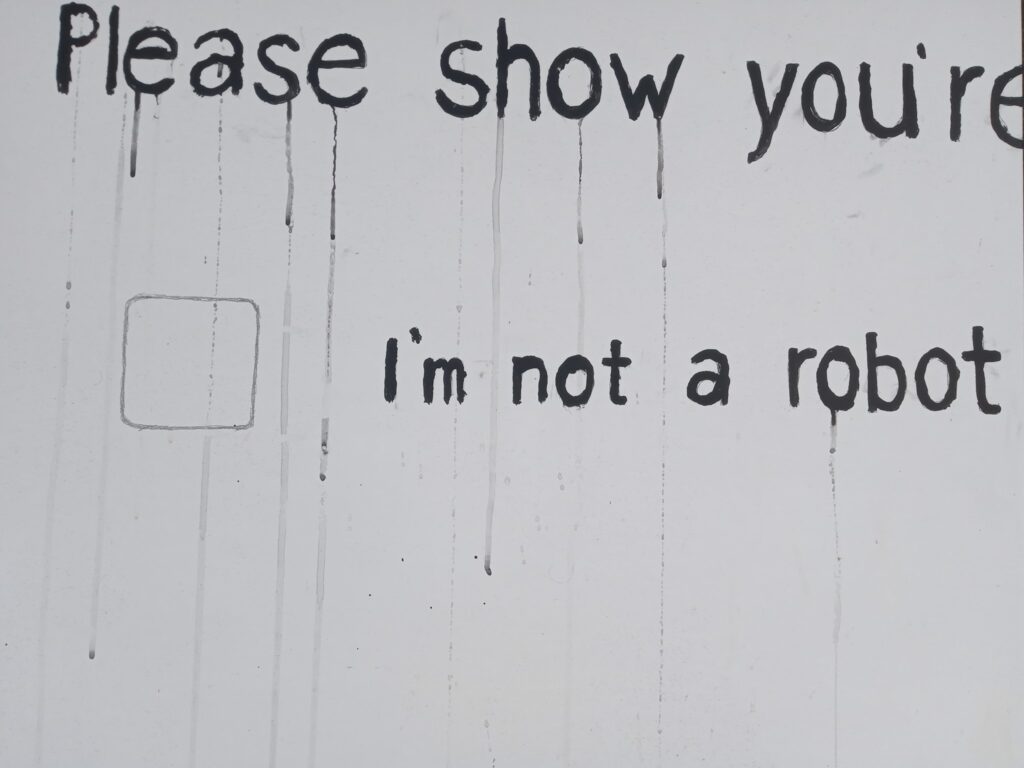
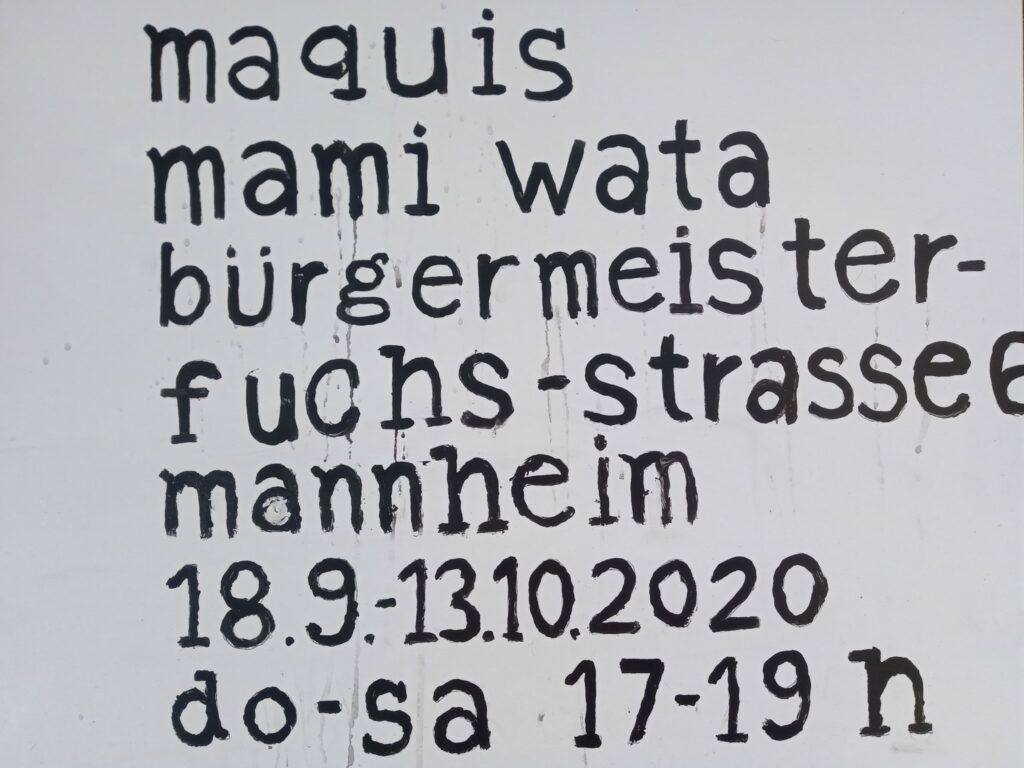
„Please show you’re not a robot“ – Text: Stefan Wäldele, 2020
Die Menschheit wacht in einem künstlichen Schlaf.
Please show you’re not a robot!
Hunderte gemalte Bläschen verdichten sich zu einer speichelähnlichen, viskosen
Schaummasse, säuerlich wie nach einem mehrfach ausgelösten Würgereiz, und
tropfen auf die Schuhe des Malers. „Ceci n‘est pas une pipe“ schreibt der
Künstler auf seine Leinwand. Eine Glasbong ersetzt Magrittes hölzerne Pfeife.
Noch ein Köpfchen, Malerei ist schon was schönes! Alles wiederholt sich, alles
dreht sich, alles dehnt sich vom Unermesslichen bis ins Unerträgliche aus… der
ganze Ballast versinkt langsam in Großmutters Schoß. Bloß nicht einschlafen
Freddy! Doch die süße Verlockung des Kontrollverlustes übermannt seine Sinne.
„Unser Kopf ist rund, damit das Denken die Richtung ändern kann“. Der Kopf ist
rund und rollt davon. Der Kampf mit seinen Dämonen hat begonnen: Als befinde er
sich im Bardo-Zustand, irgendwo zwischen Diesseits und Jenseits, ohne Wegweiser
an seiner Seite, irrt der junge Mann alleine durch geheimnisvolle Sphären. Doch
der Maler findet immer einen Weg in seine Realität zurück. Alles ist echt!
Freddy Witz‘ surrealistischer Realismus fängt dort an, wo die künstliche
Intelligenz endet.
Focusing on the topics of social justice, racist violence and border politics, For Each Of You brings three filmic works together: The Second Attack (2018) by Mala Reinhardt, Purple Sea (2020) by Amel Alzakout and Khaled Abdulwahed and Set Off (2019) by Mustafa Emin Büyükcoşkun. As a film, intervention and discussion programme, specifically developed for Mannheim-based artist-run art space Maquis Mami Wata, the programme will take place in cycles. Each cycle will be dedicated to each artistic position. The concept is inspired by the poem ‘For Each Of You’ (1968) written by Audre Lorde (1934-1992) who described herself as „Black, lesbian, mother, warrior, poet,“ who dedicated her life and and her creative work to confronting social injustices.
FOR EACH OF YOU / HER BİRİNİZ İÇİN / FÜR JEDEN VON EUCH 17.04. – 14.05.2021
Der Zweite Anschlag/ The Second Attack (2018) by Mala Reinhardt 17.04.2021
Purple Sea (2020) by Amel Alzakout&Khaled Abdulwahed 30.04.2021
Set Off (2019) by Mustafa Emin Büyükcoşkun 14.05.2021
>
>
>
>
unterstützt von


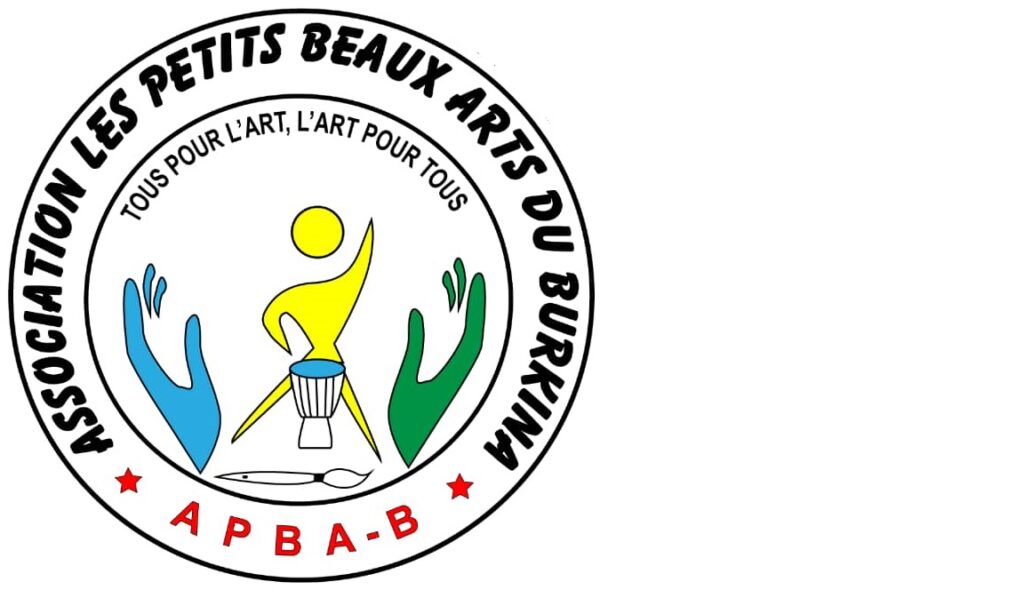
über uns
Das Maquis Mami Wata ist ein Raum für Kunst in Neckarstadt-West. Der Bildene Künstler Stefan Wäldele, Gründer und Leiter des Maquis Mami Wata, beschreibt seinen Ausstellungsraum als seine längste Performance. Mit seinem Raum unterstützt er die freie Kunstszene und schafft einen Zugang zur lokalen und internationalen Kunstwelt. Rethink differently
Team <3

Stellvertretende Leiterin: Anna Lodahl, Vermittlung

Kooperationspartnerin: Tebda Talato, bildende Künstlerin, Kuratorin, Présidente: Association Les Petits Beaux Arts du Burkina

Wissenschaftlicher Mitarbeiter mit Fokus auf Ideologie und Kulturtheorie des Westens: Thomas Schoenberger, Lecture Performance, „The Wrong Place“

Expertin für Panafrikanisches Kino: Laurentine Bayala, Filmmacherin, Kuratorin, „miniFESPACO“

Geschäftsführung/ Leitung: Stefan Wäldele, bildender Künstler, Kurator, Gründer von Maquis Mami Wata
©stefan wäldele „Schraubverschluss“ 2011- 2025
>
>
>
kontakt
MAQUIS MAMI WATA, Bürgermeister-Fuchs-Straße 6, 68169 Mannheim
info@maquismamiwata.de
>
>
>
We are currently updating our website. Stay tuned about current and upcoming exhibitions – send us a short message to info@maquismamiwata.de and we will add you to our mailing list.
https://www.instagram.com/maquismamiwata/

Maquis Mami Wata gUG (haftungsbeschränkt)
Sitz der Gesellschaft und Handelsregister Mannheim, HRB 751616
Geschäftsführung: Stefan Wäldele
©Stefan Wäldele maquis mami wata, Kunstraum, seit 2020
